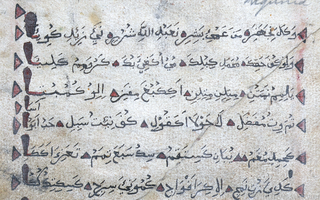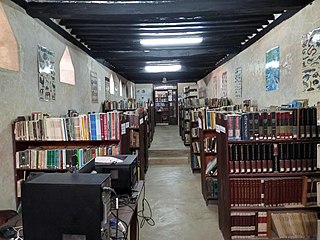See also
- African literature
- Siku Njema
- Utendi wa Tambuka "The Story of Tambuka"
- Utenzi "a form of narrative poetry"
Hamisi Akida Bin Said
Swahili literature is literature written in the Swahili language, particularly by Swahili people of the East African coast and the neighboring islands. It may also refer to literature written by people who write in the Swahili language. It is an offshoot of the Bantu culture. [1]
The first literary works date back to the beginning of the 18th century, when all Swahili literature was written in the Arabic script. [2] Jan Knappert considered the translation of the Arabic poem Hamziya from the year 1652 to be the earliest Swahili written text. Starting in the 19th century, missionaries and orientalists introduced the Latin script for writing the Swahili language.
Swahili literature has been an object of research by many western scholars since the 19th century. There is a debate regarding objectivity as a few scholars tried to establish a canon of Swahili writing. [3]
One of the main characteristics of Swahili literature is the relative heterogeneity of the Swahili language. One can find works written in Kiamu (see for example the poetry by Ustadh Mau), [4] Kimvita, Kipemba, Kiunguja, Kimrima, Kimtang'ata, Ki-Dar es Salaam and Ki-Nairobi which are considered varieties of Swahili. [5]
Swahili literature has been sometimes characterized as Islamic by some western scholars such as Jan Knappert. This approach was criticized by some experts such as Alamin Mazrui and Ibrahim Noor Shariff. [6] In fact, Swahili poetry has produced many secular works by such poets as Muyaka bin Ghassany and Muhammad Kijuma. [7]
Because of this orientalist exploration and interest in the Swahili culture and language, most of the theses made on the Swahili literature have been done outside of the native place. [8]
Swahili literature is classified into three genres: Riwaya (the novel), tamthilia (drama/play) and ushairi (poetry). [9] Scholars, however, cite the problem in the literary classification because the sense of orientation associated to genre does not work properly for Swahili literature. [10] The lack of clear and decisive parameters for genres can be illustrated by the convergence of oral and written literary forms. [11] Rajmund Ohly noted that the names of genres are not well defined while denominations are too vague to distinguish class divisions. [10]
Fiction in Swahili literature mainly consisted of oral narrative traditions. It was not until the 1940s that Swahili started to have a written fiction. Modern Swahili literature is a direct result of the standardization of Swahili. Previously, writers would write in a particular dialect to show their attachment to a certain dialect, such as Lamu, Tanga or Mombasa. The normalization of Swahili motivated writers, such as George Mhina and Lyndon Harries to promote the development of Swahili by creating a literary corpus. [12]
Swahili poetry shares many similarities to Arabic poetry. Swahili poetry or "ushairi" (from Arabic : Shîir, poetry) is still written in the traditional manner. According to an account, the traditional poetry is created to be sung rather than read. [13] It began in the northern Kenya coastal towns of Lamu and Pate before spreading to Tanga Region, Zanzibar and other nearby areas. [14] The poetic tradition is still alive today as pieces are often published in local newspapers and used in taraab songs and musical theater popular in Zanzibar and the Swahili coast. [13]
However, there are a few fundamental differences between the Swahili and Arabic poetry. With much of African influence, the two poems can hardly be compared for it is sui generis . [15]
Traditional poetry can be classified into different groups according to its form and content. It can be epic, lyrical or didactic, as well as religious or secular. [16] Examples of narrative poetry, known as utenzi, include the Utendi wa Tambuka by Bwana Mwengo (dated to about 1728) and the Utenzi wa Shufaka.
Use of Swahili prose was until recently practically restricted to utilitarian purposes. However, the traditional art of oral expression in poetry has produced a number of valuable works. It is characterized by its homiletic aspects, heroic songs, folklore ballads and humorous dialogues which accurately depict Swahili life, cultural beliefs and traditions. Because of the immediate historical aspect of the Swahili literature, especially in the 19th century, it is still a hard job to interpret many of the poems due to the lack of knowledge of the context in which the poem was written.
Hamisi Akida Bin Said

Swahili, also known by its local name Kiswahili, is a Bantu language originally spoken by the Swahili people, who are found primarily in Tanzania, Kenya and Mozambique. The number of current Swahili speakers, be they native or second-language speakers, is estimated to be over 200 million, with Tanzania known to have most of the native speakers.
Sheng is primarily a Swahili and English-based cant, perhaps a mixed language or creole, originating among the urban youth of Nairobi, Kenya, and influenced by many of the languages spoken there. While primarily a language of urban youths, it has spread across social classes and geographically to neighbouring Tanzania and Uganda.

Taarab is a music genre popular in Tanzania and Kenya. It is influenced by the musical traditions of the African Great Lakes, North Africa, the Middle East, and the Indian subcontinent. Taarab rose to prominence in 1928 with the advent of the genre's first star, Siti binti Saad.

Shaaban bin Robert, also known as Shaaban Robert, was a Tanzanian poet, author, and essayist who supported the preservation of Tanzanian verse traditions. Robert is celebrated as one of the greatest Tanzanian Swahili thinkers, intellectuals and writers in East Africa and has been called "poet laureate of Swahili" and is also known as the "Father of Swahili." He is also honoured as the national poet.

Lamu or Lamu Town is a small town on Lamu Island, which in turn is a part of the Lamu Archipelago in Kenya. Situated 341 kilometres (212 mi) by road northeast of Mombasa that ends at Mokowe Jetty, from where the sea channel has to be crossed to reach Lamu Island. It is the headquarter of Lamu County and a UNESCO World Heritage Site.
African literature is literature from Africa, either oral ("orature") or written in African and Afro-Asiatic languages. Examples of pre-colonial African literature can be traced back to at least the fourth century AD. The best-known is the Kebra Negast, or "Book of Kings" from the 14th century AD. Another well know book is the Garima Gospels, one of the oldest known surviving bible in the world, written in Ge'ez around 500 AD.

Swahili culture is the culture of the Swahili people inhabiting the Swahili coast. This littoral area encompasses Tanzania, Kenya, and Mozambique, as well as the adjacent islands of Zanzibar and Comoros along with some parts of Malawi and the eastern part of Democratic Republic of Congo. They speak Swahili as their native language, which belongs to the Bantu language family. Graham Connah described Swahili culture as at least partially urban, mercantile, and literate.

Utend̠i wa Tambuka, also known as Utenzi wa Tambuka, Utenzi wa Hirqal or Kyuo kya Hereḳali, is an epic poem in the Swahili language by Bwana Mwengo wa Athman, dated 1728. It is one of the earliest known documents in Swahili.
Jan Knappert was a well-known expert on the Swahili language. He was also an Esperantist, and he wrote an Esperanto-Swahili dictionary.
Utenzi or utend̠i is a form of narrative poetry in Swahili. Its name derives from the fact that it usually describes heroic deeds, like the medieval European gesta. Utendi, plural tendi, meaning "act" or "deed", is derived from the Swahili verb ku-tenda "to do". Well-known examples of utenzi are the Utendi wa Tambuka by Bwana Mwengo, the Utenzi wa Shufaka, and the Utenzi wa vita vya Uhud compiled around 1950 by Haji Chum. Reciting utenzi is a popular pastime on weddings and other ceremonies and feasts; often, specialized narrators are invited to do this.
Utenzi wa Shufaka is an utenzi in Swahili literature. It is composed of 285 stanzas of four lines of eight-syllables each. The poet-narrator of utenzi offers details of his lineage but never identifies himself.

Kenyan literature describes literature which comes from Kenya. Kenya has a long oral and written literary tradition, primarily in English and Swahili, the two official languages of the country.

The Swahili coast is a coastal area of East Africa, bordered by the Indian Ocean and inhabited by the Swahili people. It includes Sofala ; Mombasa, Gede, Pate Island, Lamu, and Malindi ; and Dar es Salaam and Kilwa. In addition, several coastal islands are included in the Swahili coast, such as Zanzibar and Comoros.
Chama cha Kiswahili cha Taifa is a Kenyan institution founded in 1998 responsible for the promotion of the Swahili language in Kenya. The Founding Chair is Prof. Kimani Njogu, a graduate of Yale University's department of Linguistics.
Ebrahim Hussein is a Tanzanian playwright and poet. His first play, Kinjeketile (1969), written in Swahili, and based on the life of Kinjikitile Ngwale, a leader of the Maji Maji Rebellion, is considered "a landmark of Tanzanian theater". The play soon became one of the standard subjects for examinations in the Swahili language in Tanzania and Kenya. By 1981, it had been reprinted six times.
Abdilatif Abdalla is a Kenyan writer and political activist. He was imprisoned for his support of the Kenya People's Union, and began writing poetry in solitary confinement. A collection of poems from this time were published as a book titled Sauti ya Dhiki (1973), which was awarded the Jomo Kenyatta Prize for Literature.
Up to the second half of the 20th century, Tanzanian literature was primarily oral. Major oral literary forms include folktales, poems, riddles, proverbs, and songs. The majority of the oral literature in Tanzania that has been recorded is in Swahili, though each of the country's languages has its own oral tradition. The country's oral literature is currently declining because of social changes that make transmission of oral literature more difficult and because of the devaluation of oral literature that has accompanied Tanzania's development. Tanzania's written literary tradition has produced relatively few writers and works; Tanzania does not have a strong reading culture, and books are often expensive and hard to come by. Most Tanzanian literature is orally performed or written in Swahili, and a smaller number of works have been published in English. Major figures in Tanzanian modern literature include Shaaban Robert, Muhammed Said Abdulla, Aniceti Kitereza, Ebrahim Hussein, Abdulrazak Gurnah and Penina Muhando.

Mathias E. Mnyampala (1917–1969) was a Tanzanian writer, lawyer, and poet. Mnyampala was born on 18 November according to a personal record form of 1956, but he wrote in his autobiography, Maisha ni kugharimia, that he only knew the year with accuracy. He was born in the hamlet of Muntundya depending on the village of Ihumwa in Chamwino District in Dodoma region at the time part of German East Africa. He died on 8 June 1969 in Dodoma city, Tanzania. Mnyampala wrote in Swahili, the lingua franca of East Africa, not Cigogo, the native language of his ethnic group.
Farouk Mohamedhusein Tharia Topan is the director of the Swahili Centre at the Aga Khan University. He is a specialist in the language and literature of the Swahili people. He has taught at the University of Dar es Salaam, the Institute of Ismaili Studies, and the School of Oriental and African Studies.

Lamu Fort Library is a branch of the National Museums of Kenya. The Library was initiated in 1978 as a reference library for museum's staff and researchers. In 1986 it was relocated to a more specious room at the Lamu Fort Museum.